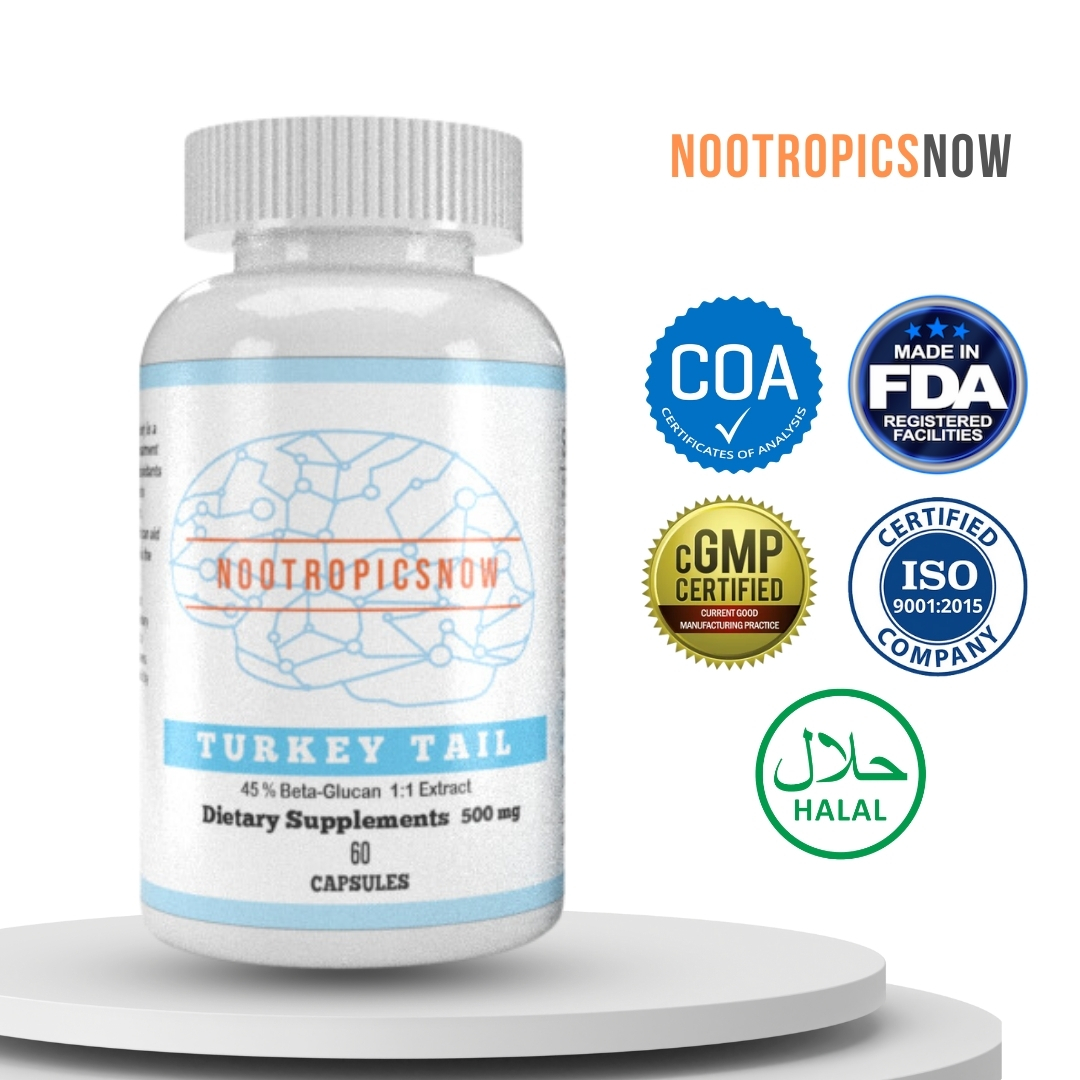Turkey Tail Mushroom: Benefits & Uses

`markdown
Turkey Tail Mushroom: A Deep Dive into Benefits, Identification, and Uses
The Turkey Tail mushroom (Trametes versicolor) is a common polypore fungus recognized for its vibrant, multi-colored bands resembling the tail feathers of a wild turkey. Besides its aesthetic appeal, it has a rich history in traditional medicine, particularly across Asia, where it’s valued for its potential health benefits. Let’s explore the various facets of this fascinating fungus.
Identifying Turkey Tail Mushroom

Proper identification is crucial before consuming any wild mushroom. Turkey Tail has some key characteristics which distinguish it from similar-looking fungi. For instance, its zonate (ringed) cap surface features a vibrant array of colors, including brown, tan, cream, gray, and even blue-ish hues. The colors are not merely superficial; they run through the tissue of the mushroom.
Key Identification Features:
Distinguishing Turkey Tail from Look-Alikes:
One common look-alike is Stereum ostrea, also known as the False Turkey Tail. Here’s how to differentiate them:
| Feature | Turkey Tail (Trametes versicolor) | False Turkey Tail (Stereum ostrea) |
|---|---|---|
| —————– | ———————————— | ————————————- |
| Underside | Pores present | Smooth or bumpy, no pores |
| Thickness | Thin and flexible | Thicker and less flexible |
| Color | Vibrant, distinct bands | Less vibrant, inconsistent bands |
| Surface Texture | Velvety or slightly fuzzy | Smooth |
Habitat and Growth
Turkey Tail is a saprotrophic fungus, meaning it obtains nutrients from decaying organic matter, primarily dead hardwood trees. It is commonly found on fallen logs, branches, and stumps in forests and woodlands. Turkey Tail is widespread across North America, Europe, Asia, and parts of South America, showcasing its adaptability to various climates and environments.
It thrives in temperate regions with ample moisture and decaying wood. You’ll often find it in clusters or overlapping shelves, contributing to its distinctive “tail” appearance. Its growth season typically extends from spring through fall, although it can persist year-round in milder climates. Look for it primarily on hardwoods like oak, maple, birch, and beech.
Historical and Traditional Uses
Turkey Tail has a long and revered history in Traditional Chinese Medicine (TCM). In TCM, it is known as Yun Zhi and is considered to have beneficial effects on the immune system, liver health, and overall vitality. It has been used for centuries to tonify Qi, strengthen the spleen, and clear dampness.
In Japan, a specific extract from Turkey Tail, known as PSK (Polysaccharide Krestin), has been approved as an adjunct treatment for cancer since the 1980s. PSK is a protein-bound polysaccharide derived from a cultivated strain of Trametes versicolor. It is widely used alongside conventional cancer treatments like chemotherapy to improve patient outcomes.
Beyond cancer support, Turkey Tail has been traditionally used for:
Scientific Research and Health Benefits
Modern scientific research is increasingly validating the traditional uses of Turkey Tail mushroom. Studies have identified several bioactive compounds that contribute to its potential health benefits, including polysaccharides, triterpenes, and antioxidants.
Immune Modulation:
Turkey Tail is renowned for its immunomodulatory effects. It contains polysaccharides, particularly PSK and PSP, which stimulate the immune system by activating immune cells such as macrophages, natural killer (NK) cells, and T lymphocytes. These cells play crucial roles in defending the body against infections and cancer.
Anti-Cancer Properties:
Research suggests that Turkey Tail extracts may have anti-cancer properties. PSK, specifically, has been extensively studied for its ability to inhibit cancer cell growth and metastasis (spread).
Gut Health and Prebiotic Effects:
Turkey Tail acts as a prebiotic, nourishing beneficial bacteria in the gut. A healthy gut microbiome is essential for overall health, including immune function, digestion, and mental well-being. By promoting the growth of beneficial bacteria like Bifidobacterium and Lactobacillus, Turkey Tail can improve gut health.
Antioxidant Activity:
Turkey Tail contains various antioxidant compounds, which help protect cells from damage caused by free radicals. Free radicals are unstable molecules that can contribute to oxidative stress, a major factor in aging and chronic diseases.
Other Potential Benefits:
Preliminary research suggests that Turkey Tail may also have benefits for:
How to Consume Turkey Tail
Turkey Tail is too tough to be eaten raw. Therefore, it needs to be processed. The best methods include:
Dosage:
The optimal dosage of Turkey Tail varies depending on the form of consumption and the individual’s health status. It’s always best to start with a low dose and gradually increase it as needed, while monitoring for any side effects. Consult with a healthcare professional or qualified herbalist for personalized dosage recommendations.
General dosage guidelines:
Safety Considerations and Potential Side Effects
Turkey Tail is generally considered safe for most people when consumed in moderation. However, some individuals may experience mild side effects, such as:
Precautions:
Sustainability and Ethical Harvesting
When harvesting Turkey Tail from the wild, it’s essential to practice sustainable and ethical harvesting methods to ensure the long-term health of the ecosystem. Only harvest mushrooms that are abundant and leave plenty behind to allow for continued reproduction. Avoid harvesting from areas that are polluted or treated with pesticides. Consider cultivating Turkey Tail yourself to ensure a sustainable and reliable supply.
Where to Buy Turkey Tail Products
Turkey Tail products are widely available online and in health food stores. When purchasing Turkey Tail supplements, look for reputable brands that use high-quality ingredients and test their products for potency and purity. Choose products that are certified organic or sustainably harvested.
Factors to consider when buying Turkey Tail products:
When considering adding Turkey Tail mushroom to your routine, remember to look for trusted brands. One option to consider is:

View Product
Conclusion
Turkey Tail mushroom is a fascinating and versatile fungus with a rich history in traditional medicine and a growing body of scientific evidence supporting its potential health benefits. From its distinctive appearance to its immunomodulatory and anti-cancer properties, Turkey Tail offers a wealth of potential for supporting overall health and well-being. By understanding its identification, uses, and safety considerations, you can confidently incorporate this remarkable mushroom into your health regimen. Remember to consult with a healthcare professional before using Turkey Tail, especially if you have any underlying health conditions or are taking medications.
`
`markdown
Harnessing the Power of Turkey Tail Mushroom: Benefits, Uses, and More
Understanding *Trametes versicolor*: The Turkey Tail Mushroom
Trametes versicolor, more commonly known as the Turkey Tail mushroom, is a fascinating fungus recognized for its striking appearance and impressive medicinal properties. Its name derives from its multi-colored bands, which resemble the plumage of a wild turkey. This mushroom is a type of bracket fungus, also known as a polypore, meaning it grows on dead wood, playing a crucial role in forest ecosystems. Understanding its characteristics, where to find it, and its health benefits is essential for anyone interested in natural remedies.
Identifying Turkey Tail: Key Features
Correct identification is paramount when foraging for any mushroom, and Turkey Tail is no exception. Several key features can help you distinguish it from similar-looking fungi. Firstly, examine the cap. Turkey Tail caps are thin and flexible, with a slightly velvety texture due to fine hairs. Secondly, look for the distinctive color bands. These bands display a range of earthy tones, including browns, reds, yellows, and even blues and greens. A true Turkey Tail will have small pores on its underside, unlike its lookalikes, which may have gills or a smooth surface.
Habitat and Distribution: Where to Find Turkey Tail
Turkey Tail mushrooms are widely distributed across the globe, thriving in temperate forests. They commonly grow on decaying hardwood trees, such as oak, maple, and birch. Look for them on fallen logs, stumps, and branches in shaded, moist environments. They typically grow in overlapping clusters, creating a visually striking display. In North America, Europe, and Asia, this mushroom is quite common. However, always be sure to positively identify it before consumption or medicinal use.
The Medicinal Marvel: Unveiling Turkey Tail’s Health Benefits
Turkey Tail mushroom is celebrated for its potent medicinal properties, primarily due to its rich content of polysaccharides. These complex carbohydrates have demonstrated significant immune-boosting, anti-cancer, and gut-health-promoting effects. The mushroom is a powerhouse of beneficial compounds, making it a valuable addition to a holistic health regimen.
Immunomodulatory Effects: Boosting the Body’s Defenses
One of the most well-known benefits of Turkey Tail mushroom is its ability to modulate the immune system. It contains polysaccharopeptides (PSPs), including Polysaccharide Krestin (PSK) and Polysaccharide Peptide (PSP), which have been extensively studied for their immunomodulatory effects. These compounds enhance the activity of immune cells, such as natural killer (NK) cells and macrophages, which are crucial for fighting off infections and preventing the growth of tumors. Clinical studies have shown that PSK can improve the immune response in cancer patients undergoing chemotherapy.
Anticancer Properties: A Natural Ally in Cancer Treatment
Turkey Tail mushroom has gained significant attention for its potential anticancer properties. Research suggests that PSP and PSK can inhibit the growth and spread of cancer cells in various types of cancer, including breast cancer, colon cancer, and lung cancer. Additionally, these compounds may enhance the effectiveness of conventional cancer treatments, such as chemotherapy and radiation therapy, while reducing their side effects. By supporting the immune system and directly targeting cancer cells, Turkey Tail mushroom offers a promising complementary approach to cancer treatment.
Gut Health and Prebiotic Effects: Nourishing the Microbiome
A healthy gut microbiome is essential for overall health, and Turkey Tail mushroom can play a role in promoting gut health. It contains prebiotics, which are non-digestible fibers that feed beneficial bacteria in the gut. By nourishing these bacteria, Turkey Tail mushroom can improve digestion, reduce inflammation, and strengthen the immune system. A balanced gut microbiome is also linked to improved mental health and a reduced risk of chronic diseases. Incorporating Turkey Tail mushroom into your diet may contribute to a healthier and more resilient gut.
Antioxidant Powerhouse: Combating Oxidative Stress
Oxidative stress, caused by an imbalance between free radicals and antioxidants in the body, can lead to cellular damage and chronic diseases. Turkey Tail mushroom is rich in antioxidants, which help neutralize free radicals and protect cells from damage. These antioxidants include flavonoids and phenols, which have been shown to have potent anti-inflammatory and anti-cancer effects. By reducing oxidative stress, Turkey Tail mushroom can contribute to overall health and longevity.
Traditional Uses: A History of Healing
The use of Turkey Tail mushroom in traditional medicine dates back centuries, particularly in Asian cultures. In Traditional Chinese Medicine (TCM), it is known as Yun Zhi and is used to tonify the spleen, resolve dampness, and treat various ailments. It has been traditionally used to support the immune system, improve liver function, and promote overall well-being. This long history of use speaks to the mushroom’s enduring value as a natural remedy.
Incorporating Turkey Tail into Your Routine: Various Forms and Preparations
Turkey Tail mushroom can be consumed in various forms, including teas, capsules, powders, and tinctures. The best method of consumption depends on individual preferences and desired effects.
Turkey Tail Tea: A Soothing and Healthful Beverage
One of the most common ways to consume Turkey Tail mushroom is in the form of a tea. To make Turkey Tail tea, simmer dried mushroom pieces in water for at least 30 minutes to extract the beneficial compounds. The longer the simmering time, the stronger the tea will be. You can add other herbs or spices, such as ginger or lemon, to enhance the flavor. Turkey Tail tea is a soothing and healthful beverage that can be enjoyed daily to support immune function and overall well-being.
Turkey Tail Capsules and Powders: Convenient and Versatile
For those who prefer a more convenient option, Turkey Tail capsules and powders are readily available. Capsules offer a pre-measured dose, making them easy to incorporate into your daily routine. Powders can be added to smoothies, soups, or other foods. When choosing capsules or powders, be sure to select a reputable brand that uses high-quality, sustainably sourced Turkey Tail mushrooms.

View Product

View Product

View Product

View Product

View Product
Turkey Tail Tinctures: Concentrated and Fast-Acting
Turkey Tail tinctures are liquid extracts of the mushroom that are typically taken sublingually (under the tongue). Tinctures offer a concentrated dose of the mushroom’s beneficial compounds and are absorbed quickly into the bloodstream. They are a convenient option for those who want a fast-acting and potent form of Turkey Tail.
Considerations and Potential Side Effects: Safety First
While Turkey Tail mushroom is generally considered safe, some individuals may experience side effects, such as digestive upset or allergic reactions. Start with a low dose and gradually increase it as tolerated. If you experience any adverse effects, discontinue use and consult with a healthcare professional. It is also important to note that Turkey Tail mushroom may interact with certain medications, such as blood thinners and immunosuppressants. Consult with your doctor before using Turkey Tail mushroom if you are taking any medications or have any underlying health conditions.
Dosage Guidelines: Finding the Right Amount
The appropriate dosage of Turkey Tail mushroom varies depending on the individual and the form of consumption. A typical dosage for dried mushroom powder is 1-3 grams per day, while the dosage for capsules and tinctures may vary depending on the concentration. It is always best to start with a low dose and gradually increase it as needed. Listen to your body and adjust the dosage accordingly.
Potential Drug Interactions: Knowledge is Key
Turkey Tail mushroom may interact with certain medications, particularly those that affect the immune system or blood clotting. If you are taking any medications, consult with your doctor before using Turkey Tail mushroom to ensure there are no potential interactions.
Pregnancy and Breastfeeding: Exercise Caution
There is limited research on the safety of Turkey Tail mushroom during pregnancy and breastfeeding. It is best to avoid using Turkey Tail mushroom during these times unless directed by a healthcare professional.
Distinguishing Turkey Tail from Lookalikes: A Foraging Guide
Accurate identification is crucial when foraging for Turkey Tail mushrooms. Several other bracket fungi may resemble Turkey Tail, but they lack the same medicinal properties. Here are some tips for distinguishing Turkey Tail from its lookalikes:
It is always best to err on the side of caution and consult with an experienced forager or mycologist if you are unsure about the identification of a mushroom.
The Future of Turkey Tail Research: Promising Avenues
Ongoing research continues to explore the potential benefits of Turkey Tail mushroom for various health conditions. Future studies may focus on its use in cancer prevention, immune support, and gut health. As more research emerges, Turkey Tail mushroom is likely to play an increasingly important role in natural medicine.
Sourcing Turkey Tail: Ethical and Sustainable Practices
When purchasing Turkey Tail mushroom products, it is important to choose a reputable brand that uses ethical and sustainable sourcing practices. Look for products that are certified organic and sustainably harvested to ensure that you are supporting responsible environmental practices.
Turkey Tail and Cancer Treatment: What the Science Says
Turkey Tail mushroom has shown promise as a complementary treatment for cancer. Studies have indicated that PSK, a key component of Turkey Tail, can improve survival rates and enhance the effectiveness of chemotherapy in certain cancer patients. While Turkey Tail is not a replacement for conventional cancer treatment, it may offer a valuable adjunct to support the immune system and improve overall outcomes.
Turkey Tail for Pets: A Natural Boost for Animal Health
The benefits of Turkey Tail mushroom extend to our furry friends as well. Many pet owners use Turkey Tail mushroom to support the immune system of their dogs and cats, particularly those with cancer or other health conditions. The dosage for pets is typically lower than for humans, and it is important to consult with a veterinarian before giving Turkey Tail mushroom to your pet.
The Synergistic Effects of Combining Turkey Tail with Other Mushrooms
Turkey Tail mushroom can be combined with other medicinal mushrooms, such as Reishi, Chaga, and Lion’s Mane, to enhance its health benefits. These mushrooms have complementary properties and can work synergistically to support the immune system, improve cognitive function, and promote overall well-being.
Conclusion: Embracing the Healing Power of Turkey Tail
Turkey Tail mushroom is a remarkable fungus with a long history of use in traditional medicine. Its potent medicinal properties, including immune-boosting, anti-cancer, and gut-health-promoting effects, make it a valuable addition to a holistic health regimen. By understanding its characteristics, sourcing it responsibly, and using it safely, you can harness the healing power of Turkey Tail mushroom to support your health and well-being.
`

